2016 FORD FOCUS ELECTRIC tires
[x] Cancel search: tiresPage 220 of 276
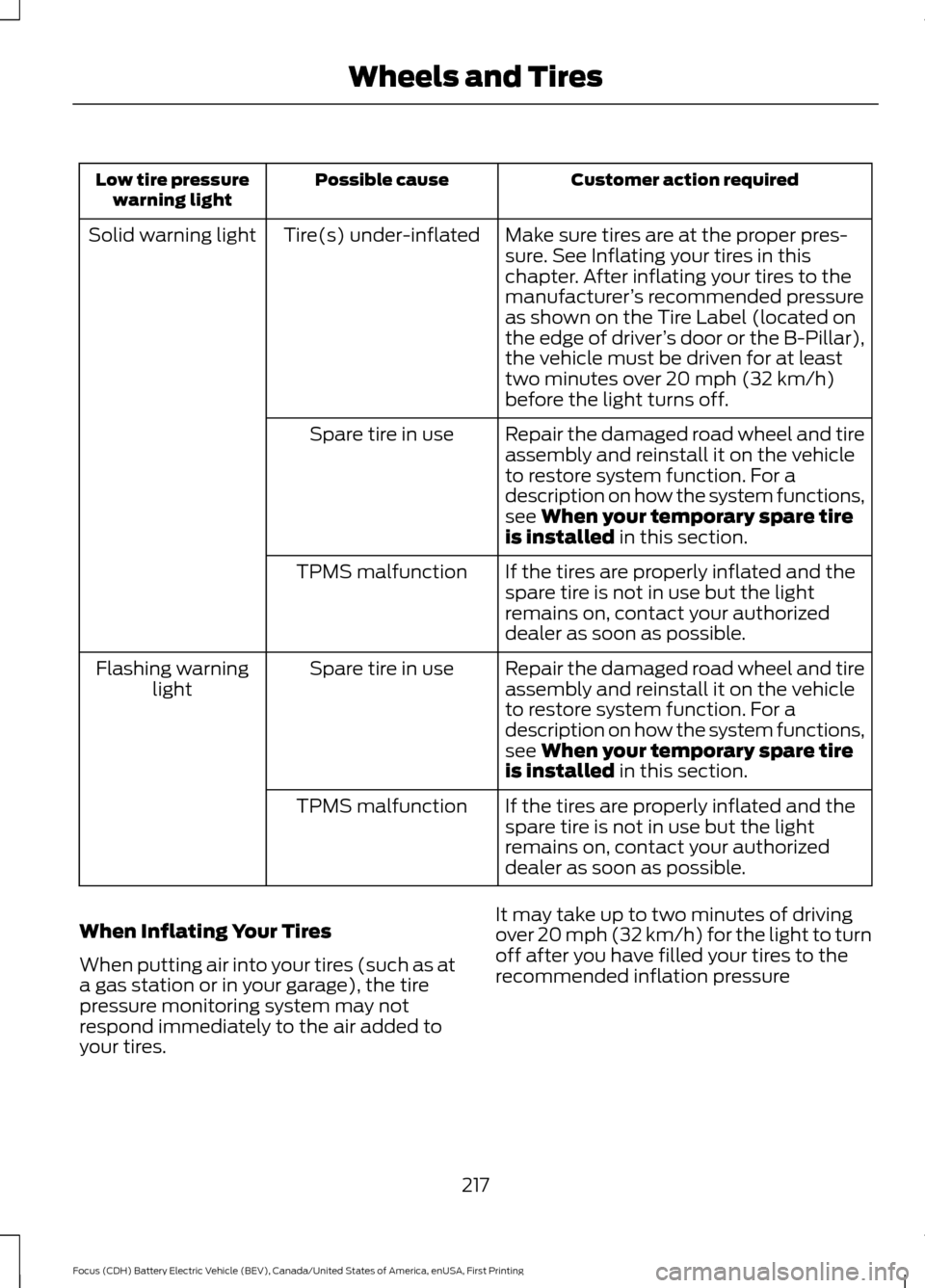
Customer action required
Possible cause
Low tire pressure
warning light
Make sure tires are at the proper pres-
sure. See Inflating your tires in this
chapter. After inflating your tires to the
manufacturer’s recommended pressure
as shown on the Tire Label (located on
the edge of driver ’s door or the B-Pillar),
the vehicle must be driven for at least
two minutes over 20 mph (32 km/h)
before the light turns off.
Tire(s) under-inflated
Solid warning light
Repair the damaged road wheel and tire
assembly and reinstall it on the vehicle
to restore system function. For a
description on how the system functions,
see When your temporary spare tire
is installed in this section.
Spare tire in use
If the tires are properly inflated and the
spare tire is not in use but the light
remains on, contact your authorized
dealer as soon as possible.
TPMS malfunction
Repair the damaged road wheel and tire
assembly and reinstall it on the vehicle
to restore system function. For a
description on how the system functions,
see
When your temporary spare tire
is installed in this section.
Spare tire in use
Flashing warning
light
If the tires are properly inflated and the
spare tire is not in use but the light
remains on, contact your authorized
dealer as soon as possible.
TPMS malfunction
When Inflating Your Tires
When putting air into your tires (such as at
a gas station or in your garage), the tire
pressure monitoring system may not
respond immediately to the air added to
your tires. It may take up to two minutes of driving
over 20 mph (32 km/h) for the light to turn
off after you have filled your tires to the
recommended inflation pressure
217
Focus (CDH) Battery Electric Vehicle (BEV), Canada/United States of America, enUSA, First Printing Wheels and Tires
Page 221 of 276

How Temperature Affects Your Tire
Pressure
The tire pressure monitoring system
monitors tire pressure in each pneumatic
tire. While driving in a normal manner, a
typical passenger tire inflation pressure
may increase about 2 to 4 psi (14 to 28
kPa) from a cold start situation. If the
vehicle is stationary overnight with the
outside temperature significantly lower
than the daytime temperature, the tire
pressure may decrease about 3 psi (21
kPa) for a drop of 30°F (17°C) in ambient
temperature. This lower pressure value
may be detected by the tire pressure
monitoring system as being significantly
lower than the recommended inflation
pressure and activate the system warning
light for low tire pressure. If the low tire
pressure warning light is on, visually check
each tire to verify that no tire is flat. If one
or more tires are flat, repair as necessary.
Check the air pressure in the road tires. If
any tire is under-inflated, carefully drive
the vehicle to the nearest location where
air can be added to the tires. Inflate all the
tires to the recommended inflation
pressure.
CHANGING A ROAD WHEEL
Important Information for Lifting
or Jacking WARNING
If you do not follow the guidelines it
will result in extensive damage to the
high voltage battery.
Lifting points
A
High voltage battery and support brace
B
218
Focus (CDH) Battery Electric Vehicle (BEV), Canada/United States of America, enUSA, First Printing Wheels and TiresB
AA
E167345
Page 222 of 276
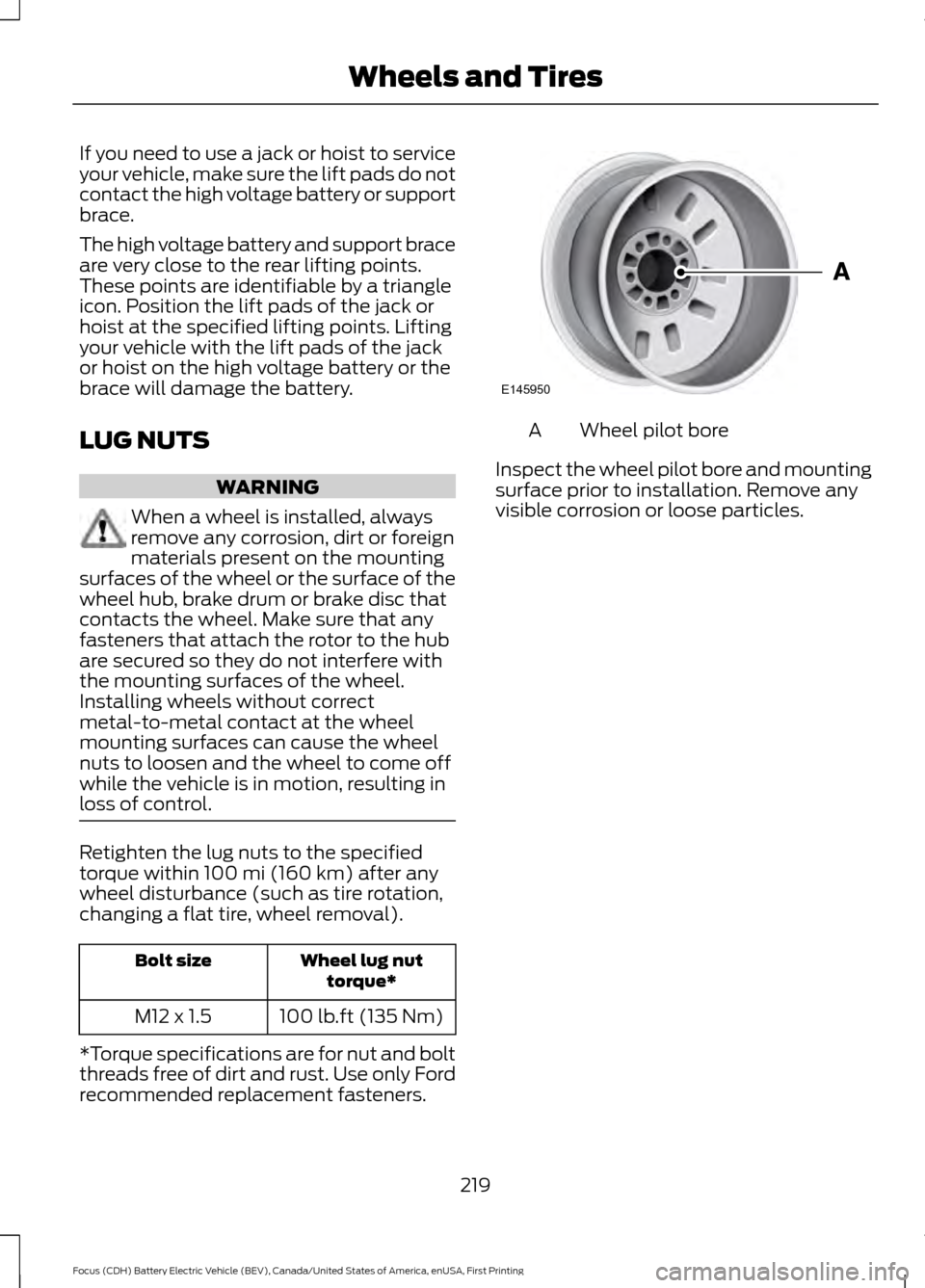
If you need to use a jack or hoist to service
your vehicle, make sure the lift pads do not
contact the high voltage battery or support
brace.
The high voltage battery and support brace
are very close to the rear lifting points.
These points are identifiable by a triangle
icon. Position the lift pads of the jack or
hoist at the specified lifting points. Lifting
your vehicle with the lift pads of the jack
or hoist on the high voltage battery or the
brace will damage the battery.
LUG NUTS
WARNING
When a wheel is installed, always
remove any corrosion, dirt or foreign
materials present on the mounting
surfaces of the wheel or the surface of the
wheel hub, brake drum or brake disc that
contacts the wheel. Make sure that any
fasteners that attach the rotor to the hub
are secured so they do not interfere with
the mounting surfaces of the wheel.
Installing wheels without correct
metal-to-metal contact at the wheel
mounting surfaces can cause the wheel
nuts to loosen and the wheel to come off
while the vehicle is in motion, resulting in
loss of control. Retighten the lug nuts to the specified
torque within 100 mi (160 km) after any
wheel disturbance (such as tire rotation,
changing a flat tire, wheel removal). Wheel lug nut
torque*
Bolt size
100 lb.ft (135 Nm)
M12 x 1.5
*Torque specifications are for nut and bolt
threads free of dirt and rust. Use only Ford
recommended replacement fasteners. Wheel pilot bore
A
Inspect the wheel pilot bore and mounting
surface prior to installation. Remove any
visible corrosion or loose particles.
219
Focus (CDH) Battery Electric Vehicle (BEV), Canada/United States of America, enUSA, First Printing Wheels and TiresE145950
Page 237 of 276

Ford Motor Company has recommended
maintenance intervals for various parts
and component systems based upon
engineering testing. Ford Motor Company
relies upon this testing to determine the
most appropriate mileage for replacement
of oils and fluids to protect your vehicle at
the lowest overall cost to you and
recommends against maintenance
schedules that deviate from the scheduled
maintenance information.
We strongly recommend the use of only
genuine Ford, Motorcraft or
Ford-authorized re-manufactured
replacement parts engineered for your
vehicle.
Additives and Chemicals
This owner's manual and the Ford
Workshop Manual list the recommended
additives and chemicals for your vehicle.
We do not recommend using chemicals or
additives not approved by us as part of
your vehicle
’s normal maintenance. Please
consult your warranty information. Oils, Fluids and Flushing
In many cases, fluid discoloration is a
normal operating characteristic and, by
itself, does not necessarily indicate a
concern or that the fluid needs to be
changed. However, a qualified expert, such
as the factory-trained technicians at your
dealership, should inspect discolored fluids
that also show signs of overheating or
foreign material contamination
immediately.
Make sure to change your vehicle
’s oils and
fluids at the specified intervals or in
conjunction with a repair. Flushing is a
viable way to change fluid for many vehicle
sub-systems during scheduled
maintenance. It is critical that systems are
flushed only with new fluid that is the same
as that required to fill and operate the
system or using a Ford-approved flushing
chemical.
Owner Checks and Services
Make sure you perform the following basic
maintenance checks and inspections every
month or at six-month intervals. Check every month
Function of all interior and exterior lights.
Tires (including spare) for wear and proper pressure. Windshield washer fluid level. Check every six months
Battery connections. Clean if necessary.
Body and door drain holes for obstructions. Clean if necessary. Cooling system fluid level and coolant strength.
Door weatherstrips for wear. Lubricate if necessary.
Hinges, latches and outside locks for proper operation. Lubricate if necessary.
234
Focus (CDH) Battery Electric Vehicle (BEV), Canada/United States of America, enUSA, First Printing Scheduled Maintenance
Page 238 of 276
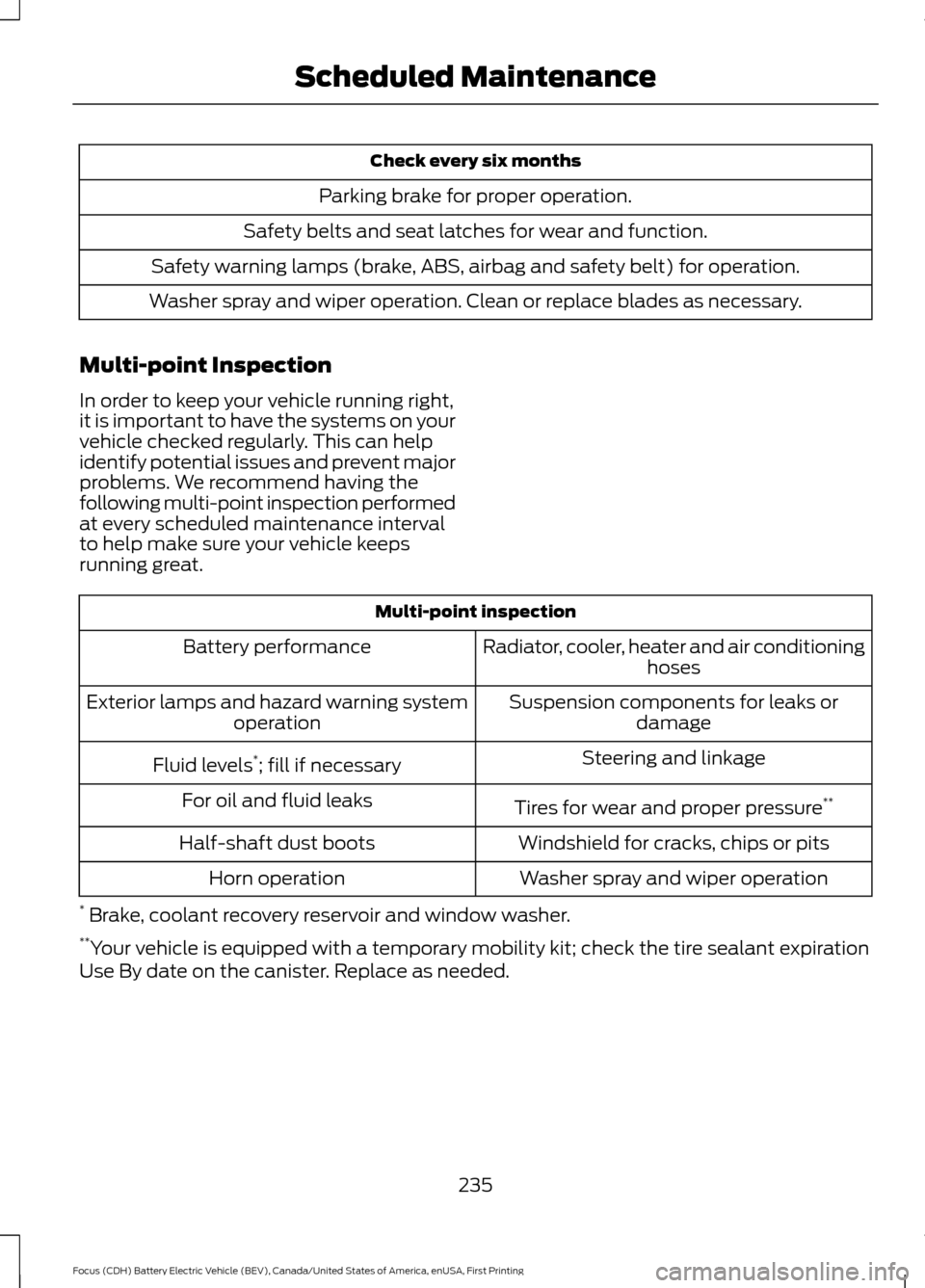
Check every six months
Parking brake for proper operation.
Safety belts and seat latches for wear and function.
Safety warning lamps (brake, ABS, airbag and safety belt) for operation.
Washer spray and wiper operation. Clean or replace blades as necessary.
Multi-point Inspection
In order to keep your vehicle running right,
it is important to have the systems on your
vehicle checked regularly. This can help
identify potential issues and prevent major
problems. We recommend having the
following multi-point inspection performed
at every scheduled maintenance interval
to help make sure your vehicle keeps
running great. Multi-point inspection
Radiator, cooler, heater and air conditioning hoses
Battery performance
Suspension components for leaks ordamage
Exterior lamps and hazard warning system
operation
Steering and linkage
Fluid levels *
; fill if necessary
Tires for wear and proper pressure **
For oil and fluid leaks
Windshield for cracks, chips or pits
Half-shaft dust boots
Washer spray and wiper operation
Horn operation
* Brake, coolant recovery reservoir and window washer.
** Your vehicle is equipped with a temporary mobility kit; check the tire sealant expiration
Use By date on the canister. Replace as needed.
235
Focus (CDH) Battery Electric Vehicle (BEV), Canada/United States of America, enUSA, First Printing Scheduled Maintenance
Page 239 of 276
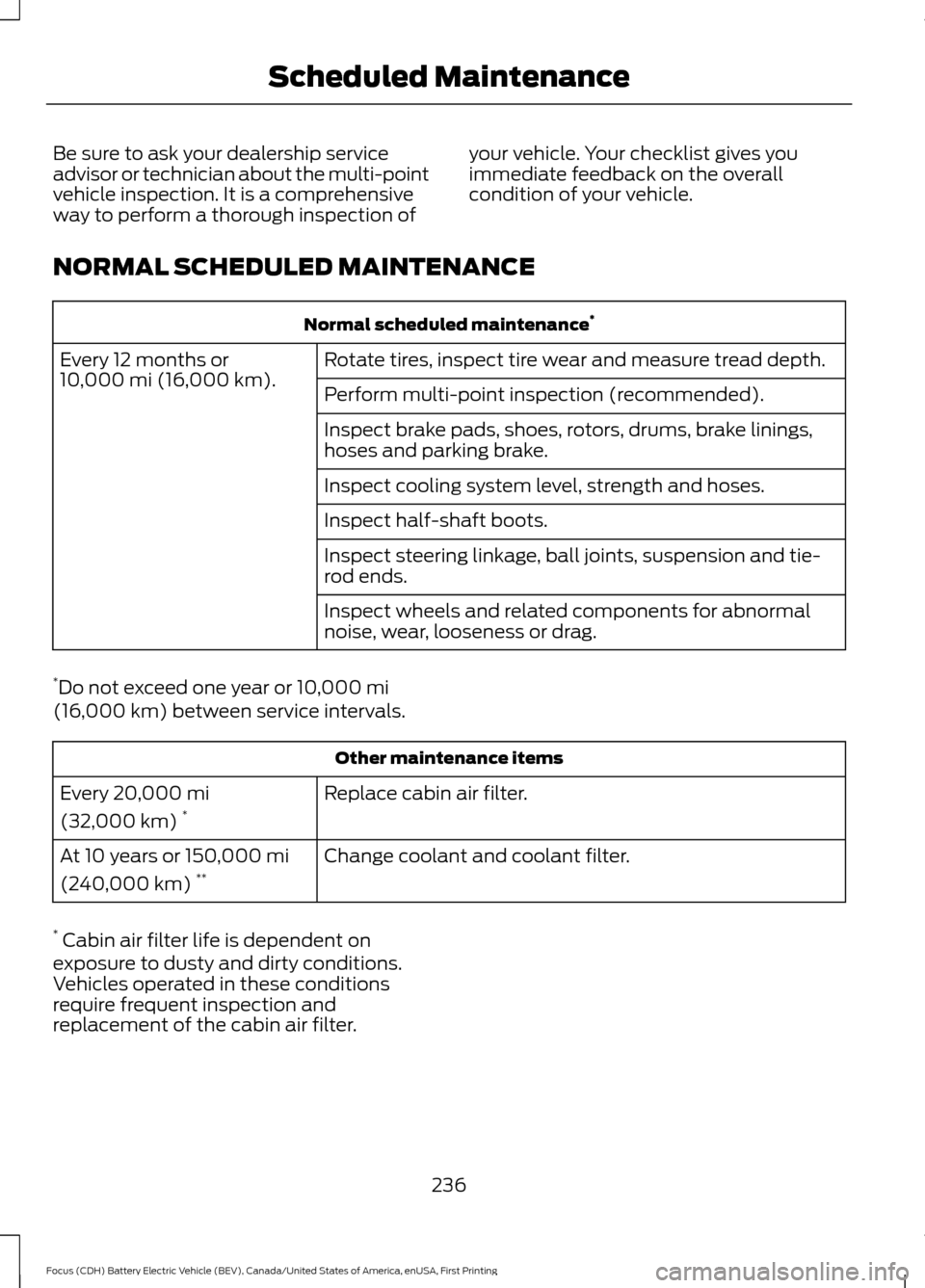
Be sure to ask your dealership service
advisor or technician about the multi-point
vehicle inspection. It is a comprehensive
way to perform a thorough inspection of
your vehicle. Your checklist gives you
immediate feedback on the overall
condition of your vehicle.
NORMAL SCHEDULED MAINTENANCE Normal scheduled maintenance
*
Rotate tires, inspect tire wear and measure tread depth.
Every 12 months or
10,000 mi (16,000 km).
Perform multi-point inspection (recommended).
Inspect brake pads, shoes, rotors, drums, brake linings,
hoses and parking brake.
Inspect cooling system level, strength and hoses.
Inspect half-shaft boots.
Inspect steering linkage, ball joints, suspension and tie-
rod ends.
Inspect wheels and related components for abnormal
noise, wear, looseness or drag.
* Do not exceed one year or
10,000 mi
(16,000 km) between service intervals. Other maintenance items
Replace cabin air filter.
Every
20,000 mi
(32,000 km) *
Change coolant and coolant filter.
At 10 years or
150,000 mi
(240,000 km) **
* Cabin air filter life is dependent on
exposure to dusty and dirty conditions.
Vehicles operated in these conditions
require frequent inspection and
replacement of the cabin air filter.
236
Focus (CDH) Battery Electric Vehicle (BEV), Canada/United States of America, enUSA, First Printing Scheduled Maintenance
Page 275 of 276
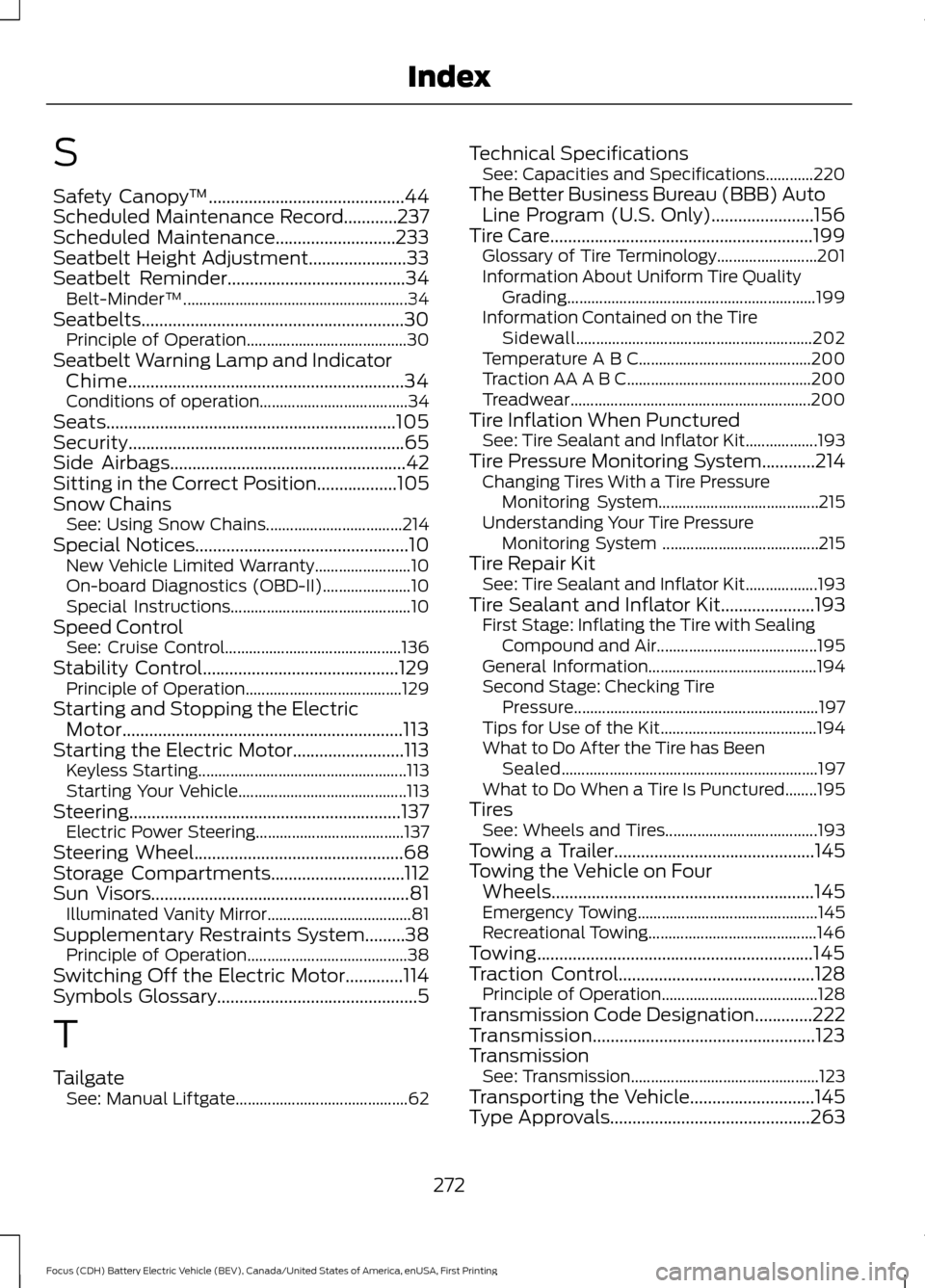
S
Safety Canopy
™............................................44
Scheduled Maintenance Record............237
Scheduled Maintenance...........................233
Seatbelt Height Adjustment
......................33
Seatbelt Reminder........................................34
Belt-Minder™........................................................ 34
Seatbelts...........................................................30 Principle of Operation........................................ 30
Seatbelt Warning Lamp and Indicator Chime..............................................................34
Conditions of operation..................................... 34
Seats.................................................................105
Security..............................................................65
Side Airbags.....................................................42
Sitting in the Correct Position
..................105
Snow Chains See: Using Snow Chains.................................. 214
Special Notices
................................................10
New Vehicle Limited Warranty........................ 10
On-board Diagnostics (OBD-II)...................... 10
Special Instructions............................................. 10
Speed Control See: Cruise Control............................................ 136
Stability Control
............................................129
Principle of Operation....................................... 129
Starting and Stopping the Electric Motor...............................................................113
Starting the Electric Motor.........................113 Keyless Starting.................................................... 113
Starting Your Vehicle.......................................... 113
Steering.............................................................137 Electric Power Steering..................................... 137
Steering Wheel
...............................................68
Storage Compartments..............................112
Sun Visors..........................................................81 Illuminated Vanity Mirror.................................... 81
Supplementary Restraints System.........38 Principle of Operation........................................ 38
Switching Off the Electric Motor.............114
Symbols Glossary.............................................5
T
Tailgate See: Manual Liftgate........................................... 62Technical Specifications
See: Capacities and Specifications............220
The Better Business Bureau (BBB) Auto Line Program (U.S. Only).......................156
Tire Care
...........................................................199
Glossary of Tire Terminology......................... 201
Information About Uniform Tire Quality Grading.............................................................. 199
Information Contained on the Tire Sidewall........................................................... 202
Temperature A B C........................................... 200
Traction AA A B C.............................................. 200
Treadwear............................................................ 200
Tire Inflation When Punctured See: Tire Sealant and Inflator Kit.................. 193
Tire Pressure Monitoring System............214 Changing Tires With a Tire Pressure
Monitoring System........................................ 215
Understanding Your Tire Pressure Monitoring System ....................................... 215
Tire Repair Kit See: Tire Sealant and Inflator Kit.................. 193
Tire Sealant and Inflator Kit
.....................193
First Stage: Inflating the Tire with Sealing
Compound and Air........................................ 195
General Information.......................................... 194
Second Stage: Checking Tire Pressure............................................................. 197
Tips for Use of the Kit....................................... 194
What to Do After the Tire has Been Sealed................................................................ 197
What to Do When a Tire Is Punctured........195
Tires See: Wheels and Tires...................................... 193
Towing a Trailer.............................................145
Towing the Vehicle on Four Wheels...........................................................145
Emergency Towing............................................. 145
Recreational Towing.......................................... 146
Towing..............................................................145
Traction Control
............................................128
Principle of Operation....................................... 128
Transmission Code Designation.............222
Transmission..................................................123
Transmission See: Transmission............................................... 123
Transporting the Vehicle............................145
Type Approvals
.............................................263
272
Focus (CDH) Battery Electric Vehicle (BEV), Canada/United States of America, enUSA, First Printing Index
Page 276 of 276

U
Under Hood Overview.................................174
Using Cruise Control....................................136
Switching Cruise Control Off......................... 136
Switching Cruise Control On.......................... 136
Using MyKey With Remote Start Systems..........................................................55
Vehicles With Ford-Approved Aftermarket Remote Start Systems.................................. 55
Vehicles With Non-Ford-Approved Aftermarket Remote Start
Systems.............................................................. 55
Using Snow Chains......................................214
Using Stability Control...............................130
Using Traction Control................................128 Switching the System Off............................... 128
System Indicator Lights and Messages.......................................................... 128
Using a Switch..................................................... 128
Using the Information Display Controls............................................................. 128
Utilizing the Mediation/Arbitration Program (Canada Only)..........................157
V
Vehicle Care
...................................................186
General Information.......................................... 186
Vehicle Certification Label........................222
Vehicle Identification Number
.................221
Vehicle Interior Overview..............................15
Vehicle Storage..............................................191 12V Battery............................................................ 192
Body........................................................................\
.. 191
Brakes..................................................................... 192
Cooling System................................................... 192
Electric Motor........................................................ 191
General.................................................................... 191
High Voltage Battery.......................................... 191
Miscellaneous...................................................... 192
Removing Vehicle From Storage.................. 192
Tires........................................................................\
. 192
Ventilation See: Climate Control.......................................... 101
VIN See: Vehicle Identification Number.............221
Voice Control...................................................69 W
Warning Lamps and Indicators................84
Anti-Lock Braking System Warning
Lamp.................................................................... 84
Battery Warning Lamp....................................... 84
Brake System Warning Lamp.......................... 84
Cruise Control Indicator .................................... 84
Direction Indicator............................................... 84
Door Ajar................................................................. 84
Fasten Safety Belt Warning Lamp.................85
Front Airbag Warning Lamp............................. 85
Headlamp and Parking Lamp Indicator ........................................................................\
........ 85
High Beam Indicator........................................... 85
Liftgate Ajar............................................................ 85
Limited Performance.......................................... 85
Low Battery............................................................ 85
Low Tire Pressure Warning............................... 85
Low Washer Fluid................................................. 85
Motor Coolant Temperature............................ 85
Powertrain Fault................................................... 85
Ready to Drive....................................................... 85
Stability Control Off Indicator......................... 86
Stability Control Warning Lamp ................... 86
Stop Safely............................................................. 86
Vehicle Plugged in............................................... 86
Washer Fluid Check......................................177
Washers See: Cleaning the Exterior............................... 186
See: Wipers and Washers................................... 71
Waxing..............................................................187
Wheel Nuts See: Changing a Road Wheel........................ 218
Wheels and Tires
..........................................193
Windows and Mirrors....................................78
Windshield Washers.......................................71
Windshield Wipers
..........................................71
Intermittent Wipe.................................................. 71
Speed Dependent Wipers.................................. 71
Wiper Blades See: Checking the Wiper Blades................... 178
Wipers and Washers......................................71
Wrecker Towing See: Transporting the Vehicle........................ 145
273
Focus (CDH) Battery Electric Vehicle (BEV), Canada/United States of America, enUSA, First Printing Index